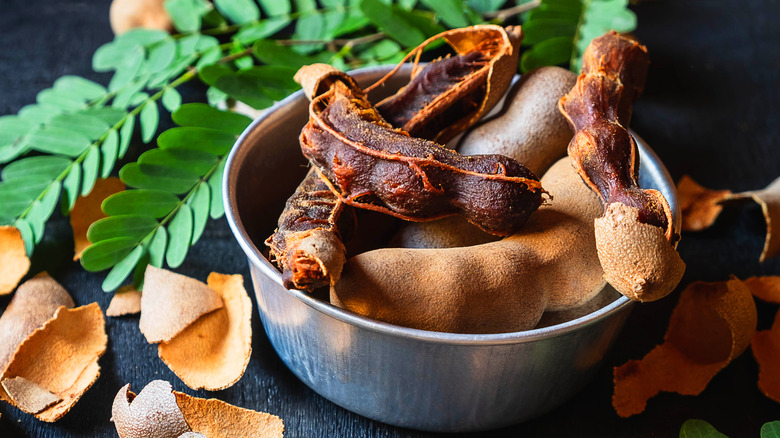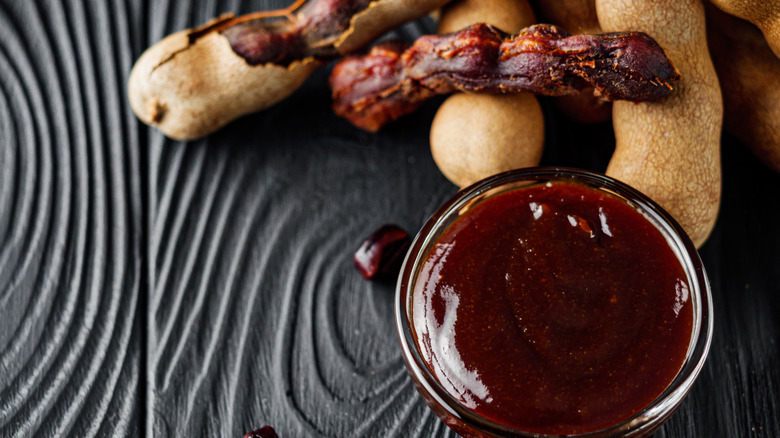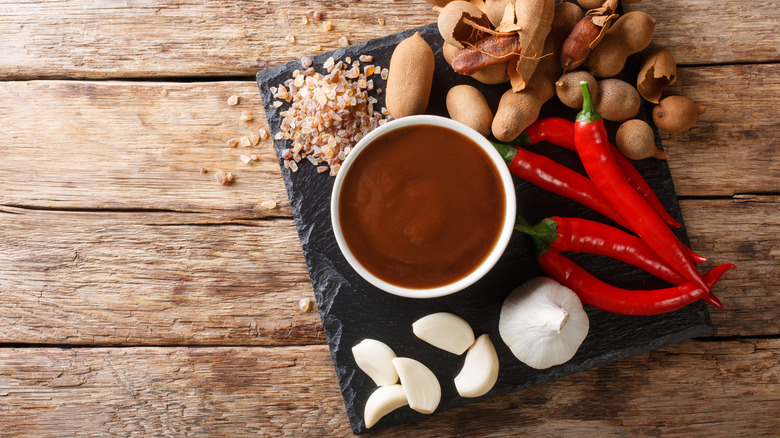The Underrated Fruit That Will Take Barbecue Sauce To A New Level
Consider the best qualities of a barbecue sauce: sticky, savory, slightly sweet, and thick enough to thoroughly coat everything on the grill from your chicken to your ribs. Even if you use barbecue sauce as a condiment for slathering on a burger bun or dipping your french fries, you still want it to be rich and complex. While there are plenty of debates in the world of barbecue about what makes for the best sauce, here's an offering to help you level up your homemade barbecue sauce: a little fruit called tamarind.
Tamarind is a small but mighty fruit common in Southeast Asian, Indian, and Latin American cuisine. A whole tamarind pod is similar in shape and appearance to a peanut, while the tamarind pulp on the inside is often sticky and ranges in flavor from sour to sweet depending on ripeness. Sticky and slightly sweet — do these qualities sound familiar? Tamarind's taste and thick, gooey texture make this fruit a dynamic and delicious choice for your next barbecue sauce.
The many forms of tamarind and your barbecue sauce
There's a reason McCormick named tamarind the 2024 flavor of the year — tamarind has made a splash in cuisines worldwide. Now it's time for barbecue to catch up. Tamarind is produced and sold in a few different ways. You can buy tamarind whole, as just the pulp packaged into a block, or in a tamarind concentrate. While these forms of tamarind don't always contain the same intense flavor as the tamarind fruit itself, it's a quick and easy way to incorporate the ingredient's essence into your recipes. Tamarind pulp blocks still contain that full-bodied tamarind flavor but require melting into a paste before use. Plus, you'll have to strain out the extra stringy pulp.
For the purposes of making a barbecue sauce, your best choice is to find tamarind paste, a form of tamarind concentrate. Tamarind paste removes the extra step of melting and straining pulp, and is the most commercially sold form of tamarind. Use the tamarind paste in a sauce for homemade tamarind ribs to bring that marmalade-like texture to your barbecue sauce. Just make sure to stock up on the napkins!
Rounding out your tamarind barbecue sauce and more tamarind uses
While tamarind paste takes on the role of secret weapon, there are other ingredients you can add to your barbecue sauce that pair delightfully well with tamarind. Warming spices such as ground cumin or allspice and a kick of heat from chili powder or dried red chilies bring out the complexity in tamarind paste. Round out those spicy notes with a bit of honey to highlight tamarind's sweetness. If you incorporate tamarind paste into your barbecue sauce and find it's a bit too sour for your liking, cut it down by adding salt, or a sweetener such as sugar or molasses.
Famously used as the flavor base in pad Thai sauce, Tamarind paste is also a wonderful flavoring agent commonly used in curries. In Latin American countries, you'll find tamarind-flavored agua frescas lush with the pasty tamarind thickening up the sweet and tangy drink. And even though tamarind paste is the best-suited form of tamarind for barbecue sauce, don't underestimate the power of tamarind oil's sweet and sour taste. Tamarind oil can be subbed in for a more neutral oil when roasting vegetables or experimenting with a homemade salad dressing. Once you get a taste of tamarind in your barbecue sauce, you'll be chomping at the bit for more ways to incorporate this underrated, complex fruit.


